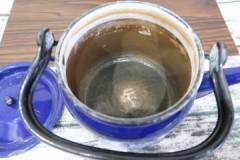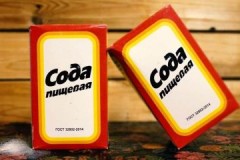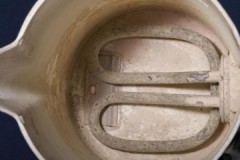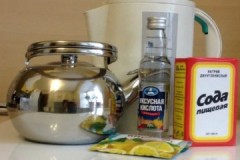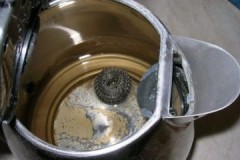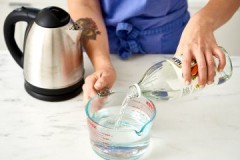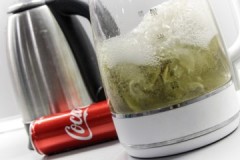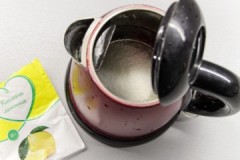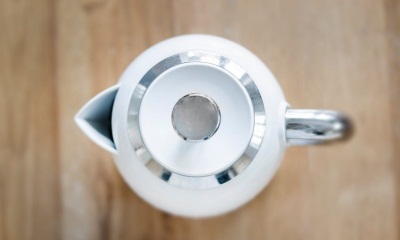 When boiling water in a kettle, limescale builds up on the walls over time. To remove it, you can use both folk recipes and special products from the category of household chemicals.
When boiling water in a kettle, limescale builds up on the walls over time. To remove it, you can use both folk recipes and special products from the category of household chemicals.
Weaker scale lends itself to cleaning immediately, with a thick layer you have to fight longer. Therefore, in order not to bring the heating device to a thorough cleaning, it is recommended to engage in scale prevention.
In this case, the teapot will delight you with its cleanliness, and boiled water will retain maximum useful properties. How to remove scale inside the kettle, even the strongest, at home, we will tell you in the article.
Content
How to remove scale with folk remedies?
Home cleaning methods are prized for ease of use, safety and low cash costs. Given the chemical composition of the scale, it is easy to find effective remedies.
After any cleaning, wipe the kettle with a soft sponge. Then fill the container with clean water, which is brought to a boil and then drained. After that, the device can be used as intended.
How to cleanse with citric acid?
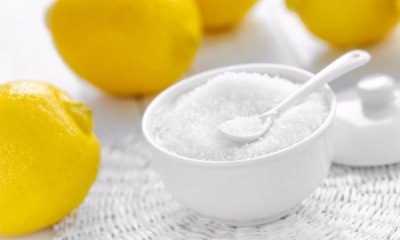 The kettle is filled 2/3 with water in which citric acid crystals are dissolved. For every liter, take a tablespoon of powder.
The kettle is filled 2/3 with water in which citric acid crystals are dissolved. For every liter, take a tablespoon of powder.
After boiling, the liquid is allowed to cool down and drained... Repeat the lemon peel if necessary. This product is suitable for all materials except enamel.
If citric acid is not in the house, and the pollution is not very strong, then you can use a natural analogue - lemon slices. They are put into a kettle, filled with 2/3 water and boiled.
Read more about descaling kettle using citric acid. here.
Vinegar
Water is also poured into the container by 2/3 of the volume, acetic acid is added at the rate of 1:10... If an essence is taken for work, then 1.5 tablespoons per 1 liter are enough.
Learn more about descaling with vinegar - in this article on the method of cleaning with vinegar and soda read here.
Soda
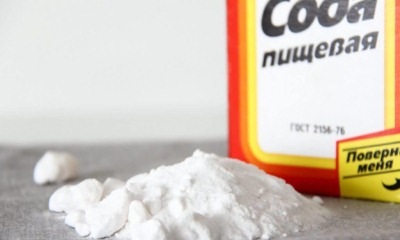 The kettle is only half filled with water. Dissolve baking soda in it (tablespoon per liter).
The kettle is only half filled with water. Dissolve baking soda in it (tablespoon per liter).
Bring to a boil over low heat. Repeat this procedure several times.
The soda solution boils up a lot, therefore, during cleaning, do not exceed the volume of liquid and boil for a long time. You can learn more about cleansing the kettle from lime deposits using soda. here.
Coca-Cola, Fanta, Sprite
Carbonated drinks are poured into a container about half the volume. Turn on the kettle and bring the liquid to a boil. After that, the reagent is left for another 20-30 minutes.
When cleaning the enameled surface, it is advisable to use drinks with a minimum amount of dyes... Details of cleaning the walls of the kettle from plaque with carbonated drinks - here.
Oxalic acid
This substance works in a similar way to citric acid. The cleaning technique is also similar. Water is poured into 2/3, a small portion of oxalic acid is added and the water is boiled for several minutes. After an hour, the liquid is drained.
Pickle or marinade
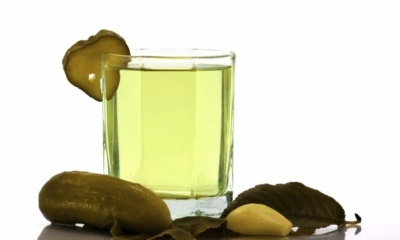 Since acetic or citric acid is used during canning, the remaining brine is used to neutralize scale.
Since acetic or citric acid is used during canning, the remaining brine is used to neutralize scale.
It is poured into a heating vessel 2/3 of its volume and brought to a boil... After that, the liquid is left for another half hour.
The method is inferior in efficiency to the previous ones, but with double cleansing it helps to cope with petrified plaque.
How to quickly remove with special tools?
In addition to folk remedies, you can use ready-made household chemicals... It is more expensive but has a good effect. The release form in most cases involves liquid, gel or tablets.
Top House
Means of German production. It is marketed in two forms: tablets and liquid. Designed for dissolving scale in kettles, coffee makers, coffee machines, as well as on ordinary dishes. The effect is due to the presence of organic acids in high concentration. Top House is odorless. The bottle cap is made with childproof function.
When using pills, take one tablet per liter of water (or two if heavily soiled). Further, the course of purification is the same.
The cost of a 500 ml bottle is approximately 250-280 rubles. The price of a package with tablets (8 pieces of 25 grams) is on average 270 rubles.
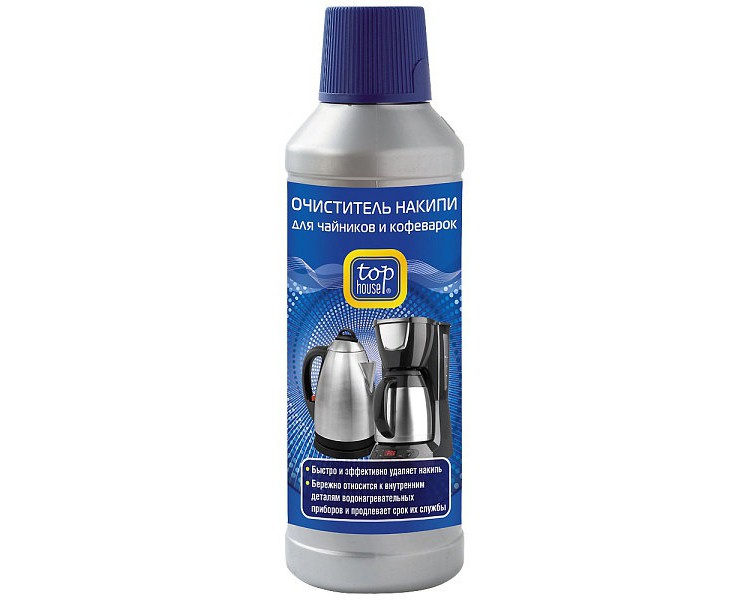
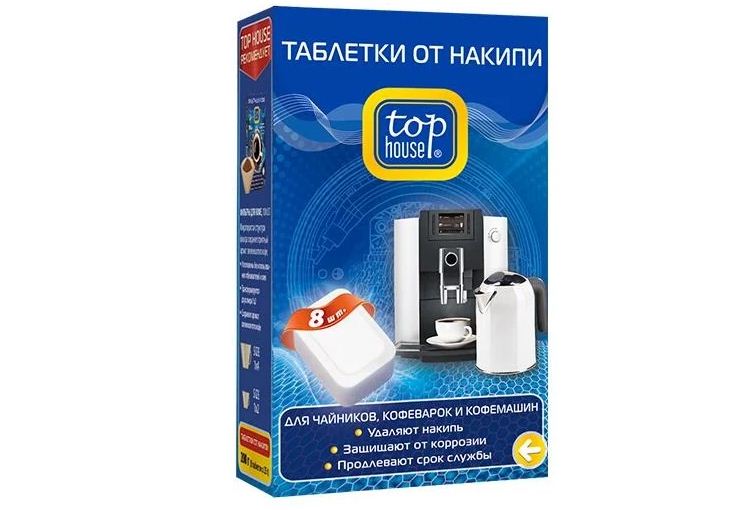
Topperr
German-made liquid concentrate is designed to remove limescale in teapots, coffee makers and other water heating devices. Considered versatile and environmentally friendly... The formula contains citric acid, surfactants (at least 5%) and auxiliary agents.
After the procedure, the kettle is thoroughly washed and a control portion of water is boiled. The cost of a 250 ml bottle ranges from 150-250 rubles.
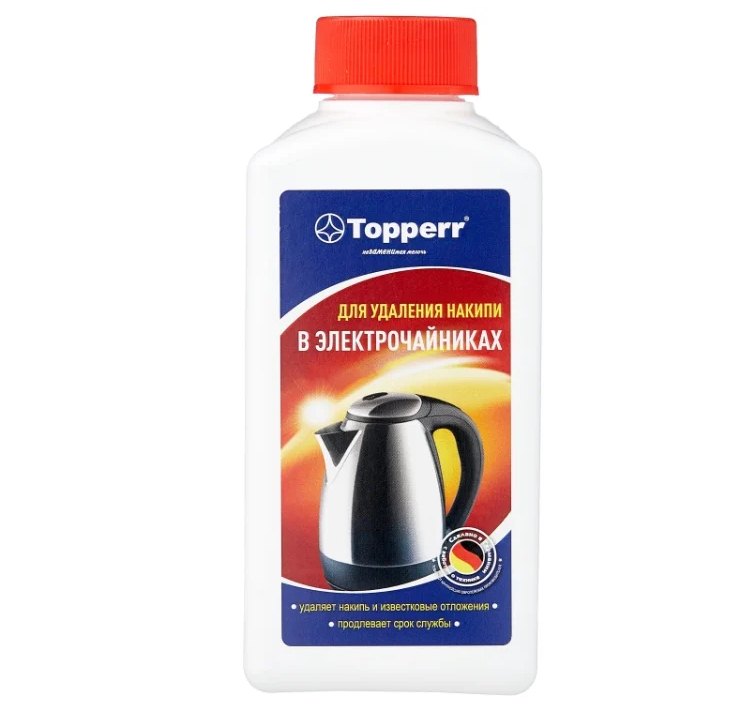
Five plus
Means from a Russian manufacturer... The liquid is produced using the latest technology using colloidal silver. This ensures not only the removal of limescale, but also the disinfection of the heating containers. It also contains a mixture of acids and an anti-corrosion additive.
The product does not leave any foreign smell and taste after cleansing, therefore it is suitable for teapots, coffee makers. The liquid is not used for enameled surfaces.
After that, the solution is drained, the kettle is washed and rinsed twice. A 500 ml bottle can be purchased for 200-250 rubles.
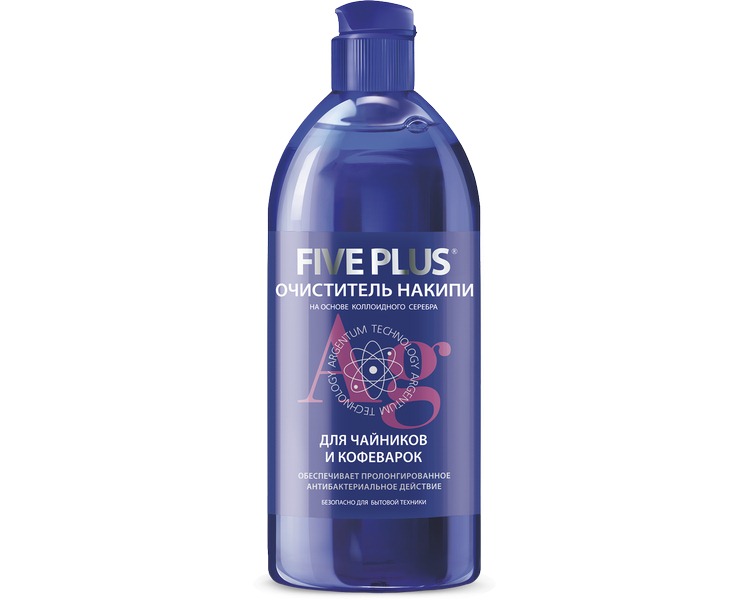
When using ready-made chemicals, it is necessary to be careful and work with gloves... If the product gets on mucous eyes, then rinse them with plenty of water.
How can you remove thick, old plaque?
If a thick layer of lime has formed on the walls of the heating device, then the cleaning procedure must be repeated twice or three times. After each cleaning, the kettle is rinsed, a new portion of water and cleaning agent is poured.
You can also enhance the result with a simultaneous combination of cleaners... For example, citric and oxalic acids can be used in pairs.
The most active are ready-made household chemicals, and from home remedies - organic acids (citric, acetic) and baking soda. Natural cleaners (sorrel leaves, lemon, cucumber pickle) do the trick weaker and slower.
Cleaning features for different types of teapots
When cleaning heating devices, a certain frequency must be observed. It is associated not only with the quality of water and the frequency of use, but also with the material from which the kettle body is made:
-
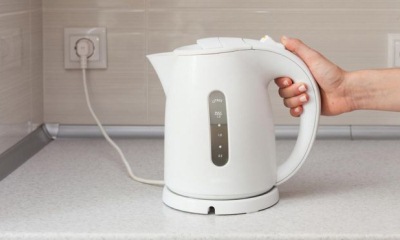 Electric kettle. The cleaning feature is associated with the type of heating element. If the device has an open spiral, then it must be cleaned more often.
Electric kettle. The cleaning feature is associated with the type of heating element. If the device has an open spiral, then it must be cleaned more often.This is due to the fact that a dense layer of lime impairs the operation of the device and lengthens the heating time of the water. The procedure, which requires boiling water, is repeated three times with an interval of 10 minutes.
- Stainless steel... The metal body well hides the accumulated limescale from the eyes. But for the sake of maintaining health, you should not neglect cleaning. It is carried out at least once a month, focusing on the degree of pollution.
- Enameled. Cleaning features are the same as in the case of stainless steel. It should be borne in mind that the enamel does not tolerate any abrasive materials, brushes and strong acids. When cleaning an enamel teapot operating on an open fire, boil it with a cleaning agent for 15-20 minutes.
- Glass. Scale on the glass and the bottom of the appliance is always noticeable and this impairs the aesthetic appearance. Therefore, with frequent boiling of water, such a container must be cleaned almost every week.
Prevention of limescale formation
Practice shows that scale is formed when using any water. However, there is always the opportunity to slow down this process and make cleaning the kettle less frequent and easier.
The walls of the appliance should be regularly wiped with a soft soapy sponge... This helps to remove in time the salt layer that has not yet adhered to the surface.
When buying a new kettle, it is recommended to give preference to modern models in which the heating element is covered with a special material. It prevents excessive scale build-up and thus protects the boiler from deterioration and increased waste of energy.
Tips on the topic of the article
To make it easier to clean the kettle from salts and to make this procedure more rare, it is advisable to put into practice several recommendations:
 to achieve the effect, cleansing is carried out in hot water;
to achieve the effect, cleansing is carried out in hot water;- after boiling, there should be a stage of infusion of the solution;
- soda is undesirable for teapots with an open spiral;
- teapots with mechanical damage should be cleaned with care;
- it is allowed to combine agents of the same chemical nature.
Conclusion
Descaling the walls of a kettle is not a difficult problem if you use the right methods and follow the instructions. Both home remedies and store products are suitable as effective cleaners.
To facilitate the cleaning process, you need to monitor the condition of the kettle, wash it on time and use purified water.
